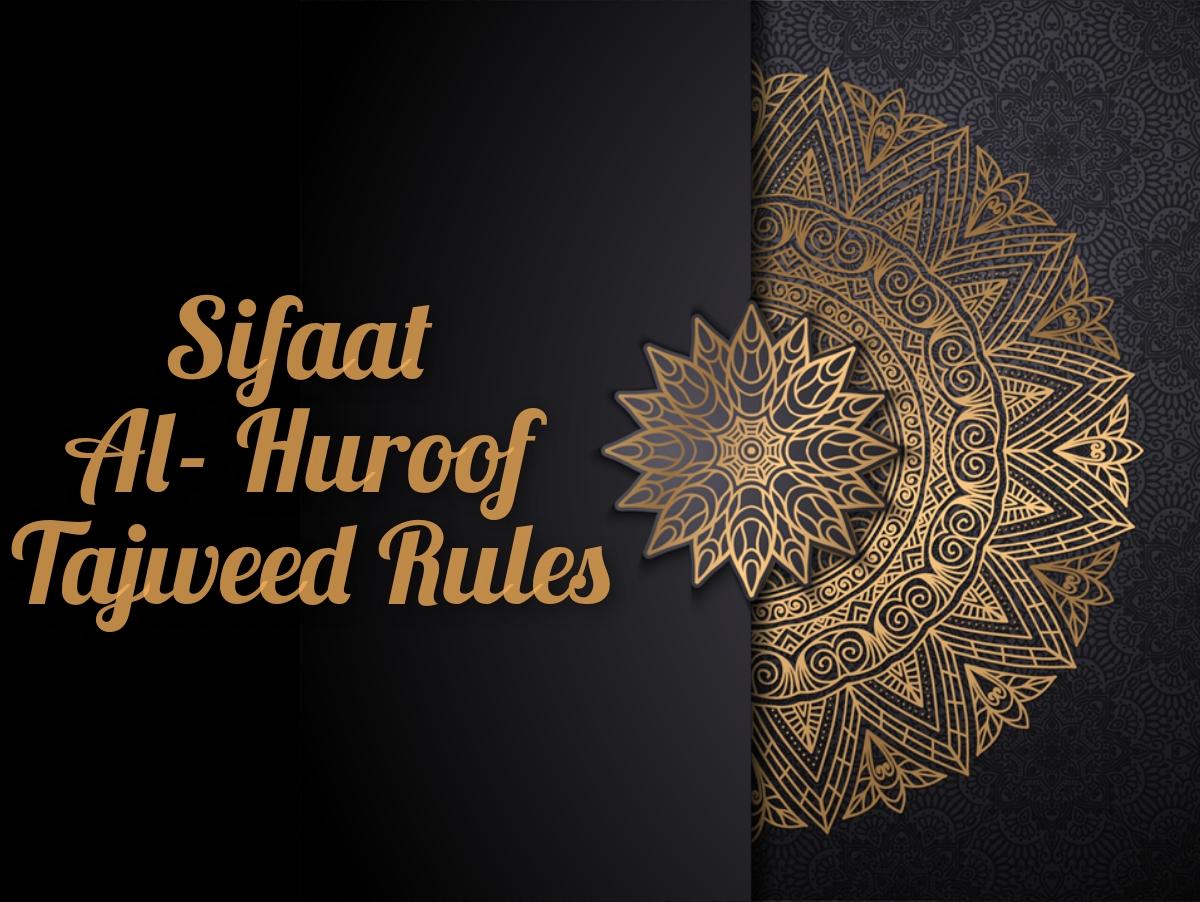Sifaat Al-Huroof
Sifaat refers to the characteristic(s) of the letter to distinguish the letters that share the same makhaarij. Sifaat are divided into two types: 1- Sifaat Mutadaaddah :- 10 Characteristics that have opposites.
- 7 characteristics that have no opposites.
 The second Sifah: Jahr
Jahr means the discontinuation of the breath when pronouncing the letter. It has a clear vibration of the
vocal cords.
The quality of jahr is found in the remaining 19
letters which are called (مجهورة) or loud
عظم وزن قارئ ذي غض جد طلب
Note:
(in the picture below that the imprisonment of the running of breath is a strong characteristic since the letter that does not have breath running with it, relies on the articulation point more than one that does.
The second Sifah: Jahr
Jahr means the discontinuation of the breath when pronouncing the letter. It has a clear vibration of the
vocal cords.
The quality of jahr is found in the remaining 19
letters which are called (مجهورة) or loud
عظم وزن قارئ ذي غض جد طلب
Note:
(in the picture below that the imprisonment of the running of breath is a strong characteristic since the letter that does not have breath running with it, relies on the articulation point more than one that does.
 Letter Laam ل
The Third Sifah: Shiddah
Shiddah means the discontinuation of the sound while pronouncing the letter causing it to rely greatly on its makhraj in the letters which are collected in the phrase:
أجد قط بكت
These letters are further divided into:
مهموسة -1(Mahmoosa): ك + ت
مجهورة-2 (Majhoora) : قطب جد + أ
Note:
Shiddah: running of the sound is imprisoned, but with Jahr running of the breath is imprisoned.
Letter Laam ل
The Third Sifah: Shiddah
Shiddah means the discontinuation of the sound while pronouncing the letter causing it to rely greatly on its makhraj in the letters which are collected in the phrase:
أجد قط بكت
These letters are further divided into:
مهموسة -1(Mahmoosa): ك + ت
مجهورة-2 (Majhoora) : قطب جد + أ
Note:
Shiddah: running of the sound is imprisoned, but with Jahr running of the breath is imprisoned.
 The Third Sifah: Shiddah
Shiddah means the discontinuation of the sound while pronouncing the letter causing it to rely greatly on its makhraj in the letters which are collected in the phrase:
أجد قط بكت
These letters are further divided into:
مهموسة -1(Mahmoosa): ك + ت
مجهورة-2 (Majhoora) : قطب جد + أ
Note:
Shiddah: running of the sound is imprisoned, but with Jahr running of the breath is imprisoned.
The Third Sifah: Shiddah
Shiddah means the discontinuation of the sound while pronouncing the letter causing it to rely greatly on its makhraj in the letters which are collected in the phrase:
أجد قط بكت
These letters are further divided into:
مهموسة -1(Mahmoosa): ك + ت
مجهورة-2 (Majhoora) : قطب جد + أ
Note:
Shiddah: running of the sound is imprisoned, but with Jahr running of the breath is imprisoned.
 The Fifth Sifah: Rakhawah
Rakhawah means the continuation of the sound while pronouncing the letter causing weakness in its reliance on its makhraj.
The letters that have this characteristic are all the rest of
the Arabic letters except the letters of shiddah (أجد قط بكت) and
At-Tawassut لن عمر)
Note:
The letter sheen comes from the middle of the tongue and it’s مهموس (has Hams)because vocal cords do not vibrate.
Timing of the letters :
1-when it is saakin: كتب
2- it is mutaharrik: يستبشرون
Note:
Timing of letter with kasra = Timing of letter with Dammah = Timing with letter Fatha
The Sixth Sifah: Isti’la’
Isti’la’ means the elevation of the back tongue towards the roof of the mouth when pronouncing these letters that have this characteristic are those in the group
7 letters are:
خ ص ض غ ط ق ظ
The Fifth Sifah: Rakhawah
Rakhawah means the continuation of the sound while pronouncing the letter causing weakness in its reliance on its makhraj.
The letters that have this characteristic are all the rest of
the Arabic letters except the letters of shiddah (أجد قط بكت) and
At-Tawassut لن عمر)
Note:
The letter sheen comes from the middle of the tongue and it’s مهموس (has Hams)because vocal cords do not vibrate.
Timing of the letters :
1-when it is saakin: كتب
2- it is mutaharrik: يستبشرون
Note:
Timing of letter with kasra = Timing of letter with Dammah = Timing with letter Fatha
The Sixth Sifah: Isti’la’
Isti’la’ means the elevation of the back tongue towards the roof of the mouth when pronouncing these letters that have this characteristic are those in the group
7 letters are:
خ ص ض غ ط ق ظ
- These seven letters are also known as the letters of tafkheem (Heavy letters)
 The Seventh Sifah: Istifal
Istifal means the absence of pressuring the letter to the roof of the mouth due to the lowering of the deepest part of the tongue when pronouncing a letter of istifaal .All letters except 7 letters of isti’laa’ are letters of Istifaal: س
etc– ث – ب – ج – ي
This is how the correct Arabic pronunciation for letter ك , as shown in the following diagram:
The Seventh Sifah: Istifal
Istifal means the absence of pressuring the letter to the roof of the mouth due to the lowering of the deepest part of the tongue when pronouncing a letter of istifaal .All letters except 7 letters of isti’laa’ are letters of Istifaal: س
etc– ث – ب – ج – ي
This is how the correct Arabic pronunciation for letter ك , as shown in the following diagram:
 The Eighth Sifah: Infetah
Infetah means keeping the tongue separated from the roof of the mouth while pronouncing a letter.
The letters of al-infetah are the remaining letters in the Arabic alphabet after the four letters.
The Tenth Sifah: Itbaaq
Itbaaq means the adhesion of the tongue to the roof of the mouth when pronouncing these letters that have the characteristic:
ص ض ط ظ
Notes:
Letters have Isti’la’ and Infetah
غ خ ق characteristics three letters.
The Eighth Sifah: Infetah
Infetah means keeping the tongue separated from the roof of the mouth while pronouncing a letter.
The letters of al-infetah are the remaining letters in the Arabic alphabet after the four letters.
The Tenth Sifah: Itbaaq
Itbaaq means the adhesion of the tongue to the roof of the mouth when pronouncing these letters that have the characteristic:
ص ض ط ظ
Notes:
Letters have Isti’la’ and Infetah
غ خ ق characteristics three letters.
- Letters have Isti’la’ and Itbaaq characteristics four letters: ظ ط ض ص So letters of Isti’la’ and Itbaaq are heavier than letters have Isti’la’ and Infetah.


 The Twelfth Sifah: Ismaat
The Twelfth Sifah: Ismaat
Ismaat means desisting,
refusal The letter that has this characteristic is considered
heavier because it doesn’t rely on the tip of the tongue.
It’s letters is the remaining letters in the Arabic letters after the six letters of Idhlaq
This shortcode LP Profile only use on the page Profile




